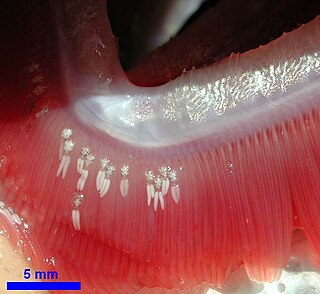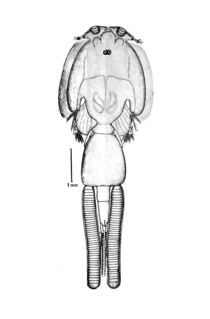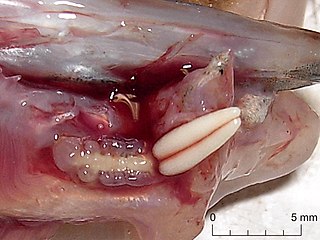Related Research Articles
Tantulocarida is a highly specialised group of parasitic crustaceans that consists of about 33 species, treated as a subclass of the class Hexanauplia. They are typically ectoparasites that infest copepods, isopods, tanaids, amphipods and ostracods.

Siphonostomatoida is an order of copepods, containing around 75% of all the copepods that parasitise fishes. Their success has been linked to their possession of siphon-like mandibles and of a "frontal filament" to aid attachment to their hosts. Most are marine, but a few live in fresh water. There are 39 recognised families:

The Cyclopoida are an order of small crustaceans from the subclass Copepoda. Like many other copepods, members of Cyclopoida are small, planktonic animals living both in the sea and in freshwater habitats. They are capable of rapid movement. Their larval development is metamorphic, and the embryos are carried in paired or single sacs attached to first abdominal somite.

Poecilostomatoida are an suborder of copepods. Although it was previously considered a separate order, recent research showed it to be nested within the Cyclopoida

Ergasilidae is a widespread family of copepods and comprises many species. The type genus is Ergasilus. With a few doubtful exceptions all ergasilids are parasitic on fishes.
Bomolochidae is a family of parasitic copepods, containing the following genera:
Hamaticolax unisagittatus is a species of parasitic copepod belonging to the family Bomolochidae. It is a parasite on the gills of the common snook and has only been recorded in coastal waters off Rio de Janeiro State. In one study over half of the host fish sampled in this area carried this parasite.
Shiinoidae is a family of parasitic copepods. The first species in the family to be described was Shiinoa occlusa, a single immature female of which was discovered on the fish Scomberomorus commerson, and described by Kabata in 1968. A second species, S. inauris, was found on Scomberomorus regalis and described by Roger Cressey in 1975, who also erected the family to hold the genus Shiinoa alone. A second genus was added in 1986, containing the single species Parashiinoa mackayi, which had been found on the fishes Pomadasys maculatus and P. argenteus. Nine species are now recognised in the two genera:
The Chitonophilidae are a family of parasitic copepods, with these genera:

Clausidiidae is a family of parasitic copepods of the suborder Poecilostomatoida, containing the following genera:
Cletocamptus is a genus of marine and brackish-water copepods, containing the following species:

Caligus is a genus of sea lice in the family Caligidae. The species are parasites of marine fishes and could be vectors of viruses. As of 2017, the World Register of Marine Species includes the following species:
Hamaticolax is a genus of parasitic copepods belonging to the family Bomolochidae. Its members can only be distinguished from the closely related genus Acantholochus by the presence of an accessory process on the claw of the maxillipeds. It includes the following species:
Nicothoe is a genus of copepods, containing the following species:
Chondracanthus is a parasitic copepod genus in the family Chondracanthidae, containing the following species:

Acanthochondria is a genus of copepods, containing the following species:

Lepeophtheirus is a genus of sea lice. The best-known species is L. salmonis, the salmon louse. Other species include L. pectoralis, which uses flatfish as its host, particularly the European flounder, and is also the type species of the genus Lepeophtheirus.
Eudactylinidae is a family of copepods most of which live as parasites on the gills of elasmobranch fishes; two genera lives on the gills of teleost fishes. The family Eudactylinidae contains the following genera:
Eudactylina is a genus of copepods that parasitise elasmobranch fishes. It contains the following species:
Tracheliastes is a genus of parasitic copepods, containing the following species:
References
- ↑ F. N. Morales Serna & S. Gómez (2010). "A new bomolochid copepod parasitic on bullseye puffer Sphoeroides annulatus (Jenyns) from Mexico, with reassignment of some species of Acantholochus Cressey and Hamaticolax Ho & Lin" (PDF excerpt). Zootaxa . 2336: 36–50.
- 1 2 Ju-shey Ho & T. Chad Walter (2010). T. Chad Walter & Geoff Boxshall (ed.). "Acantholochus Cressey, 1984". World Copepoda database. World Register of Marine Species . Retrieved October 28, 2010.